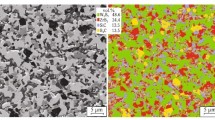Conclusions
A range of volume phase characteristics is proposed for suspensions, semifinished articles, and materials based on them, which will facilitate the determination and objective assessment of a variety of materials.
A direct link is demonstrated between the chemical nature of the oxide solid phase, typical ionic potential, and the phase composition of the suspension, and the state of the disperse medium, and also the nature of rheological behavior.
A number of principles are formulated for obtaining heat-resistant cements, and their classification is proposed, based on the volume proportion of liquid chemically bonded during the setting of the system.
A new principle is proposed for obtaining heat-resistant cements based on incorporating in the composition of low-active (with high ionic potential values) materials, small additions of highly active materials. Castings of corundum composition were obtained with σbend after drying in the range 5–15 MPa.
Similar content being viewed by others
Literature cited
Yu. E. Pivinskii and A. G. Romashin, Quartz Ceramic [in Russian], Metallurgiya, Moscow (1974).
Yu. E. Pivinskii, Ogneupory, No. 2, 34–42 (1978).
Yu. E. Pivinskii, Ogneupory, No. 6, 39–46 (1980).
Yu. E. Pivinskii and M. L. Mityakin, Ogneupory, No. 5, 48–52 (1981).
Yu. E. Pivinskii, Zh. Prikl. Khim.,54, No. 8, 1702–1708 (1981).
Yu. E. Pivinskii et al., Neorg. Mater.17, No. 9, 1706–1710 (1981).
Yu. E. Pivinskii et al., Ogneupory, No. 4, 50–56 (1981).
V. A. Bevz et al., Steklo Keram., No. 2, 36 (1982).
K. D. Nekrasov, Heat-Resistant Concrete [in Russian], Stroiizdat, Moscow (1957).
K. K. Strelov and P. S. Mam'kin, Technology of Refractories [in Russian], Metallurgiya, Moscow (1978).
M. M. Sychev, Inorganic Adhesives [in Russian], Khimiya, Leningrad (1974).
A. V. Volzhenskii, Stroit. Mater. No. 8, 19–21 (1981).
K. G. Krasil'nikov, L. V. Nikitina, and N. N. Skoblinskaya, Physicochemical Inherent Deformations in Cement Stone [in Russian], Stroiizdat, Moscow (1980).
M. C. Day and D. Selbin, Theoretical Inorganic Chemistry, 2nd. Ed., Van Nostrand Reinhold (1969).
S. R. Morrison (ed.), The Chemical Physics of Surfaces, Plenum Publ. (1976).
S. L. Golynko-Vol'fson, M. M. Sychev, L. G. Sudakas, et al., Chemical Principles of Technology and Use of Phosphate Bonds and Coatings [in Russian], Khimiya (1968).
R. Ya. Popil'skii and F. V. Kondrashev, Pressing Ceramic Powders [in Russian], Metallurgiya, Moscow (1968).
N. R. Fedorov, Introduction to the Chemistry and Technology of Special Cements, Part 1 [in Russian], Leningrad, Lensovet Leningrad Inst. Technology (1976).
V. D. Glukhovskii (ed.), Alkaline and Alkaline-Earth Hydraulic Cements and Concretes [in Russian], Vishcha Shkola, Kiev (1979).
A. A. Pashchenko, V. P. Servin, and E. A. Starchevskaya, Cement Materials [in Russian], Vishcha Shkola, Kiev (1975).
M. M. Sychev, Zh. Prikl. Khim.,49, No. 10, 2121–2132 (1976).
M. M. Sychev, Zh. Prikl. Khim.,54, No. 9, 2036–2043 (1981).
I. S. Kainarskii, É. V. Degtyareva, and I. G. Orlova, Corundum Refractories and Ceramics [in Russian], Metallurgiya, Moscow (1981).
G. V. Kukolev and A. G. Karaulov, Ogneupory, No. 4, 168–178 (1963).
A. G. Dobrovol'skii, Slip Casting [in Russian], Metallurgiya, Moscow (1977).
N. F. Fedorov, in: Advances in Physics and Chemistry of Silicates [in Russian], Nauka, Leningrad (1978), pp. 244–265.
L. P. Ivanova, Ogneupory, No. 2, 44–48 (1982).
A. A. Furman, Inorganic Chlorides [in Russian], Khimiya, Moscow (1980).
R. F. Fel'dman and D. D. Boduén, in: Sixth Int. Congress on Cement Chemistry [in Russian], Vol. 2, Stroiizdat (1976), pp. 288–294.
V. P. Kirilishin, Silicoconcrete [in Russian], Budivil'nik, Kiev (1975).
A. N. Sokolov, S. Z. Tsikorina, E. V. Petrova, et al., Production of Refractories [in Russian], Regional Thematic Collections, MChM SSSR, VIO, Leningrad, No. 3(46) (1974), pp. 61–77.
G. I. Gorchakov, Building Materials [in Russian], Vysshaya Shkola, Moscow (1981).
A. M. Neville, Properties of Concrete, 2nd Ed., Halsted Press (1973).
Additional information
Translated from Ogneupory, No. 6, pp. 49–60, June, 1982.
Rights and permissions
About this article
Cite this article
Pivinskii, Y.E. Phase relationships, important working properties, and classification of ceramic and other bonding systems. Refractories 23, 309–322 (1982). https://doi.org/10.1007/BF01387364
Issue Date:
DOI: https://doi.org/10.1007/BF01387364




